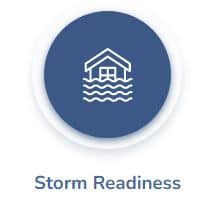Floods, Mudslides & Swiftwater
BEFORE A FLOOD
- Find out if you live in a flood-prone area from your local emergency management agency and by finding out the flood history of your area.
- Find out whether your property is above or below flood level.
- Be aware of your community’s warning system for flooding.
- Study flood preparation literature and start putting the information into practice.
- If you live in an area that is frequently prone to flooding, stockpile emergency building materials, including plywood, plastic sheeting, lumber nails, hammer and saw, pry bar, shovels, and sandbags.
- Have check valves installed in building sewer traps to prevent flood waters from backing up in sewer drains.
- As a last resort, use large corks or stoppers to plug showers, tubs, or basins.
- Have an evacuation plan and route. Be sure to practice the evacuation procedures before a true emergency occurs. Find out what the community’s evacuation plan is from the local emergency management agency. This should contain the safest routes to shelters. Make sure that you have several route planned, in case the first and/or second choices are flooded out.
- Have disaster supplies on hand including food, water, essential medications, hygiene supplies etc… for all family members including pets
DURING A FLOOD WATCH
- Listen to local TV and radio stations for the latest storm information.
- Have a battery operated radio available in case of loss of power so that you can continue to monitor the situation.
- Fill bathtubs, sinks, and jugs with clean water in case water becomes contaminated.
- Bring outdoor belongings, such as patio furniture, indoors.
- If time allows move all valuable items from lower floors to higher ones.
- If you are instructed to do so by local authorities, turn off all utilities at the main switch and close the main gas valve.
- Be prepared to evacuate.
DURING A FLOOD
If Indoors:
- Turn on battery-operated radio or television to get the latest emergency information.
- Get your preassembled emergency supplies.
- If told to leave, do so immediately.
If Outdoors:
- Climb to high ground and stay there.
- Avoid walking through any floodwaters. If it is moving swiftly, even water 6 inches deep can sweep you off your feet.
If In A Car:
- If you come to a flooded area, turn around and go another way.
- If your car stalls, abandon it immediately and climb to higher ground. Many deaths have resulted from attempts to move stalled vehicles.

